Temptation: The Demons of James Ensor
The Art Institute of Chicago
Sunday, November 23, 2014 through Sunday, January 25, 2015
Regenstein Hall
One needs to stand in front of James Ensor’s drawings, prints and paintings to truly understand his significance. James Ensor (1860-1949) lived and worked most of his life in the Belgian coastal city of Ostend. As a student at the John Herron School of Art in Indianapolis, Indiana, I can recall sifting through the library’s stacks and stumbling upon “Christ’s Entry Into Brussels in 1889”, 1888. I was dumfounded by this cavalcade of grotesque masked figures surrounding the petite haloed Christ at center. The small reproduction left a lasting impression. Over time, I returned to Ensor and developed a fascination for him and other early Expressionists. Dismissed by Les XX, this work was not publically exhibited until 1929 and spent most of its time hung in his home or studio. This masterwork is now in the prestigious Getty Collection.
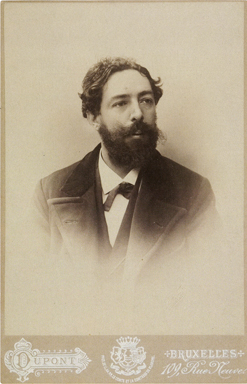
Dupont. James Ensor in 1887. Collection of Patrick Florizoone.
The centerpiece of Temptation: The Demons of James Ensor is “The Temptation of St. Anthony”, 1887. This massive assembled artwork consisting of 51 separate pieces of heavily worked paper shows, in contrast to earlier depictions, the Saint kneeling in prayer at the mercy of the turbulent modern world. Full of late 19th century and religious iconography, there is a clear sense of the artist’s spiritual affinities and his concerns for man’s relationship to God and society. Ensor was a deeply contemplative man who struggled with demons within self and beyond throughout his life. This is highlighted in the low level lighting reminiscent of a medieval chapel coupled with up-to-date technology that allows one to retrieve significant details of the specific elements of Temptation.
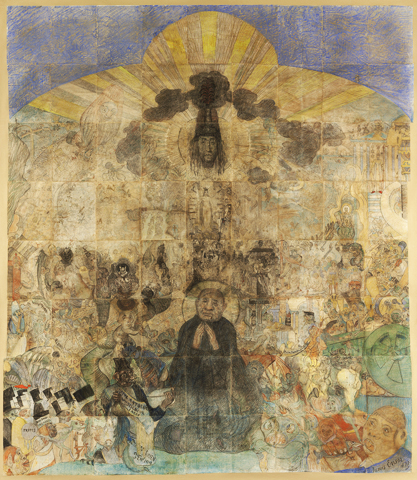
James Ensor. The Temptation of Saint Anthony, 1887. The Art Institute of Chicago. Regenstein Endowment and the Louise B. and Frank H. Woods Purchase Fund. © 2014 Artists Rights Society (ARS), New York / SABAM, Brussels.
The presence of evil spirits can also be seen in “Poster for the Salon des Cent” (Self-Portrait with Devils), 1898. Ensor stands flanked by ghouls, devils and other beasts in a field of opaque yellow ochre. Lithography was a highly prominent medium that illustrates a refined, yet tactile, simplicity. Between 1895 and 1898, Toulouse-Lautrec, Bonnard, Moreau, Lalique, Jossot, and other relevant practitioners participated in this seminal exhibition.
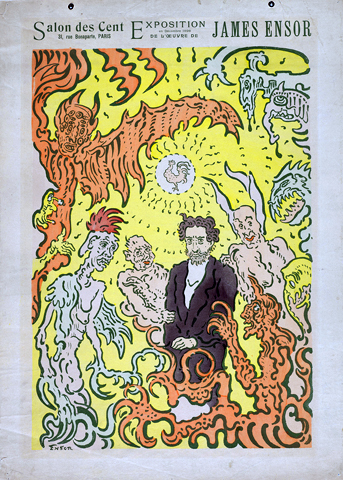
James Ensor. Poster for the Salon des Cent (Self-Portrait with Devils), 1898. The Art Institute of Chicago. Gift of Arthur Aldis. © 2014 Artists Rights Society (ARS), New York / SABAM, Brussels
In “Skeleton Painting”, c. 1896, Ensor stands working at easel with a skull replacing his youthful bearded visage in densely packed studio. Painted at a time where Ensor had fully developed an eclectic vibrant palette and imagery consisting of tormented masks, the heavy impasto contrasting delicate use of line is best viewed in close quarters.
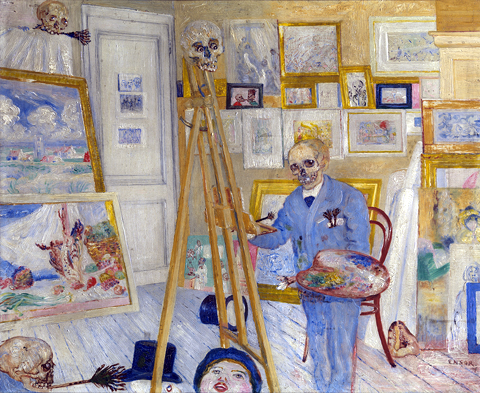
James Ensor. Skeleton Painting, c. 1896. Royal Museum of Fine Arts Antwerp, 3112 © 2014 Artists Rights Society (ARS), New York / SABAM, Brussels. Image: Royal Museum of Fine Arts Antwerp. © Lukas-Art in Flanders vzw. Photo by Hugo Maertens.
There is much speculation about the painting, “Intrigue”, 1890. This bizarre masquerade has been described as referencing a broken marriage. Art historians have noted the work as describing Ensor’s sister Mitche’s failed matrimony to a German-Chinese art dealer and the impact this event had upon their daughter. Rather than revealing the subjects, Ensor once again employs his use of masks offering a frightening assembled group marching in step. Gruesome wedding party flanks the bride and groom. A female figure in red holds a limp baby doll while others display expressions of uncertainty and a sad euphoria. The congregation is nothing short of hideous.
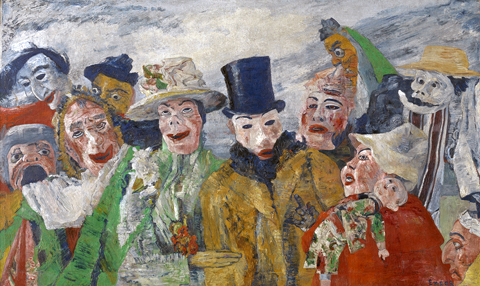
James Ensor. The Intrigue, 1890. Royal Museum of Fine Arts Antwerp, 1856. © 2014 Artists Rights Society (ARS), New York / SABAM, Brussels. Image: Royal Museum of Fine Arts Antwerp. © Lukas-Art in Flanders vzw. Photo by Hugo Maertens.
The painting, “The Bad Doctors”, 1892, resonates most appropriately with current concerns related to medical experimentation and torture. Five ghoulish doctors hold archaic tools while performing what appears to be vivisection upon a painfully obese patient sitting upon pillowed gurney with the specter of Death entering scene at left. Two demonic torsos sit upon a shelf in the upper third; one pointing to a static clock indicating that the end is nigh.
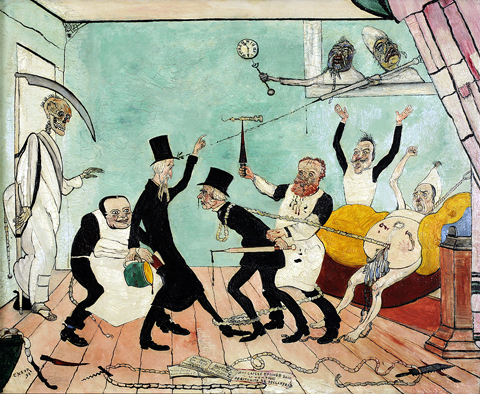
James Ensor. The Bad Doctors, 1892. Université Libre de Bruxelles. © 2014 Artists Rights Society (ARS), New York / SABAM, Brussels. Image: Université Libre de Bruxelles, on deposit in the Royal Museums of Fine Arts of Belgium, Brussels / photo: Royal Museums of Fine Arts of Belgium, Brussels.
This exhibition is a curious selection for the holiday season, yet should not be missed. One will find upon viewing that James Ensor’s oeuvre is best experienced in person. The layered symbolism and textured artworks cannot be easily felt via printed book or online. There is certainly reason for pilgrimage; the exhibit clearly reminds of our ongoing fascination with the darker sides of humanity and the relevance of perseverance associated with creating ones own identity.
A catalog for the exhibition, James Ensor – Temptation: The Demons of James Ensor, 2014, by Susan M. Canning (Author), Patrick Florizöone (Author), Nancy Ireson (Author), Kimberly Nichols (Author), Herwig Todts (Preface) can be found at: http://www.artinstituteshop.org/item.aspx?productId=6423
Review by Chester Alamo-Costello


